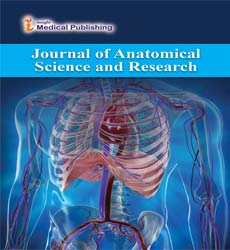Brief Note on Electromyography
Brilan Karanmianaa*
Department of Surgery, Rothman Institute, Thomas Jefferson University, Philadelphia, Pennsylvania, USA
- *Corresponding Author:
- Brilan Karanmianaa
Department of Orthopaedic Surgery,
Rothman Institute,
Thomas Jefferson University,
Philadelphia,
Pennsylvania,
USA
Tel: +251913567098
E-mail: karanmianaa@rothmanortho.com
Received Date: November 25, 2021; Accepted Date: December 09, 2021; Published Date: December 16, 2021
Citation: Karanmianaa B (2021) Brief Note on Electromyography. J Anat Sci Res Vol.4 No.6:003.
Description
Electromyography (EMG) is a testing method that evaluates the function of the muscles and nerves. Thin needles are inserted through the skin and into the muscles by the providers. Electrodes on the needles' ends measure muscle activity as you move your muscles. EMG is used by medical professionals to diagnose injuries, muscle illness, and neuromuscular disorders.
EMG is usually considered to be safe and complications are extremely rare. After the test, some patients (especially those who take blood thinner drugs) may bleed. Infections can arise where the needles pierced the skin on a rare event.
A very thin needle electrode is inserted into the muscle by the health care professional through the skin. The electrical activity emitted by your muscles is picked up by the electrode on the needle. This activity is visible on a nearby monitor and audible via a speaker. Nerve Conduction Studies (NCS) and Needle Electrode Examination (NEE) are the two sections of an EMG study (NEE).
Needle electrodes were used to record motor units in the first dorsal interosseus muscle of normal human volunteers, as well as the surface electromyogram. Signal averaging was used to estimate the wave form contributed by each motor unit to the surface EMG. The square root of the threshold force at which the unit was recruited increased the peak-to-peak amplitude of the wave shape contributed to the surface EMG. by a motor unit. The wave form's peak-to-peak duration was unaffected by the threshold force. This muscle has a homogeneous distribution of large and small motor units, and the muscular fibres that make up a motor unit can be widely spread. Based on the sample of motor units recorded, the corrected surface EMG. was estimated as a function of force. At low force levels, motor unit recruitment has the most critical role, whereas at greater force levels, increasing firing rate plays a larger role. The widespread experimental fact that the mean rectified surface EMG. varies linearly with the force generated by a muscle is explored, as well as possible basis for this result. At moderate to high force levels, EMG potentials and contractile responses may both sum nonlinearly, but the rectified surface EMG is still roughly linearly proportional to the force produced by the muscle.
The researchers describe a new method for objectively measuring localised muscle exhaustion. The method is based on analysing the power spectrum of myoelectric signals collected from muscles fatigue. It allows for in-the-moment studies and generates statistically based fatigue criteria. The results are explained in terms of variations in muscle action potential conduction velocity and the rate at which tiredness develops.
The electromyogram is interpreted according to some standards (EMG). There is frequently a linear relationship between muscle force and smoothed rectified EMG in static isometric contractions (SRE). However, it should be remembered that multiple muscles are usually engaged at the same time around a joint. This means that the relationship between a single muscle's SRE and the overall joint moment does not have to be linear. The force-length-velocity relationship, as well as the elastic characteristics of muscle, should be considered throughout motions. Furthermore, EMGs recorded during concentric movements are greater than those recorded during isometric actions. Another factor to consider when comparing force to EMG is the fact that the force signal has lower frequency content than the rectified EMG. Finally, limited speed of activation and deactivation procedure results in a 50 to 200 ms delay of muscle force relative to EMG.
Following brief static contractions, myotatic reflexes can be improved. The reasoning for these procedures was questioned and re-examined using electromyography because static contractions are frequently used as a prelude to muscular stretch (EMG). Static (S), contract-relax (CR), and contract-relax with agonist (hip flexors) contraction were used by twenty-one female gymnasts to achieve hamstring stretch (CRAC). Across stretch situations, hip joint angles and intra-individual electromyograms were compared statistically. The CRAC method generated considerably more hamstring EMG activity (P 0.05) in 12 individuals than the other strategies. Only one person had a higher level of muscular activation while using the S technique. In eight subjects, no significant variations in EMG activity were identified across stretch situations, implying that the relative efficiency of the stretch strategies differed by individual. At low levels of muscle activation, involuntary paroxysmal tremor activity was occasionally detectable in EMG records of most participants. While the CRAC approach appeared to contribute to increased muscular stiffness, it resulted in the greatest increases in hip flexion. Minimum discomfort and maximum perceived stretch effectiveness were found to be strongly connected to one another, as well as reducing EMG activity, but not range of motion.
Open Access Journals
- Aquaculture & Veterinary Science
- Chemistry & Chemical Sciences
- Clinical Sciences
- Engineering
- General Science
- Genetics & Molecular Biology
- Health Care & Nursing
- Immunology & Microbiology
- Materials Science
- Mathematics & Physics
- Medical Sciences
- Neurology & Psychiatry
- Oncology & Cancer Science
- Pharmaceutical Sciences
